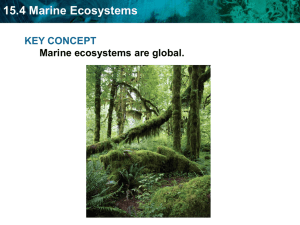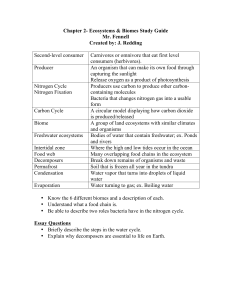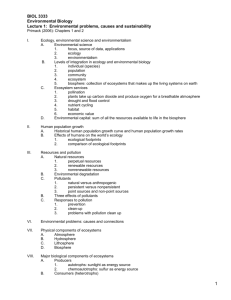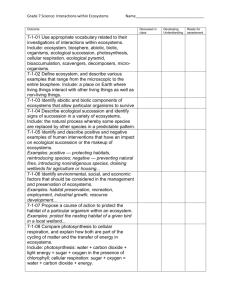PPT Format
advertisement
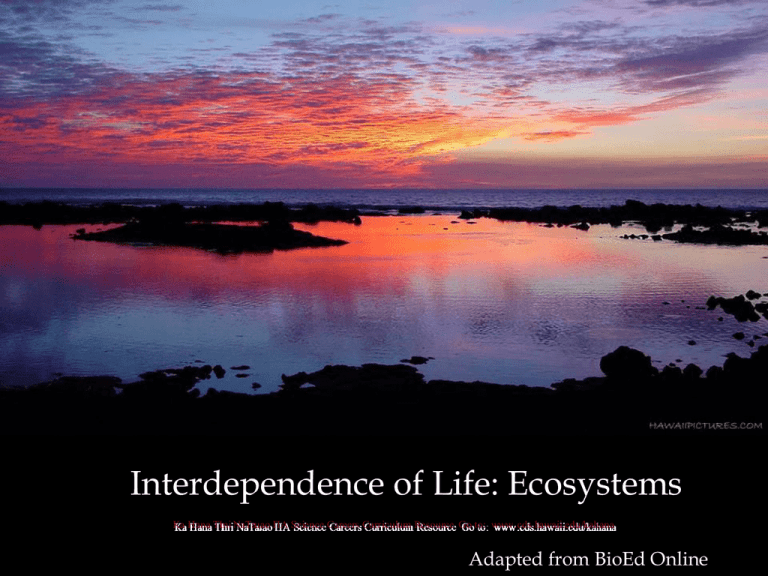
Interdependence of Life: Ecosystems Ka Hana ΤImi NaΤauao ΠA Science Careers Curriculum Resource Go to: www.cds.hawaii.edu/kahana Adapted from BioEd Online Discuss this Ecological Terminology Which of these words do you know? Environment Ecology Biotic vs. Abiotic Population & Community Ecosystem Biosphere Biomass Banded Spiny Lobster – Ula – Panulirus marginatus Geez, I can’t even pronounce my own name! PART I: Class Activity Time! How can we learn a whole lot of new stuff without a whole lot of effort? EASY - just try memorize (or take quick notes) on 3 of the next 10 slides! Do this with 1 or 2 partners if you like. Your effort will be rewarded in a game afterwards! The next 10 slides are about: Ecosystems (3 slides) Zonation (3 slides) Energy (4 slides) READY? 1. Ecosystems are … All members of a community, along with their physical and chemical environments. Dude! Am I biotic or abiotic or wut?! They … Vary greatly in size Are Dynamic energy flow chemical cycling Change over time (called succession) Coral Reefs are rich, diverse and productive ecosystems 2. Aquatic Ecosystems (types) Freshwater Flowing Water Lakes Wetlands Estuaries Oceans (see next slide) Kawainui Marsh I’m looking for waterfront, quiet kine ‘hood … l’dat! 3. Ocean Ecosystems Ocean Zones Intertidal or littoral Coastal or neritic Coral Reefs Open Ocean Benthic Queen’s Bath Kalapana 4. Zonation in Lakes 5. Zonation in a Marine Environment 6. Zonation in a Loko Pu‘uone (type of Hawaiian fishpond) All ponds are in the Photic Zone Ponds include Intertidal &/or Littoral Zones Benthic zone of ponds has many organisms living off decomposing organic matter Eurtrophic lakes are more shallow & have rich nutrients 7. Primary Production (Light Energy) The conversion of light energy to chemical energy is called photosynthesis. Plants use the energy captured in photosynthesis for maintenance and growth. The energy that is accumulated in plant biomass is called “net primary production.” 8. Energy Flow in Ecosystems Producers of Energy (Autotrophs) Consumers of Energy (Heterotrophs) Trophic Levels Ecological Pyramids of Energy Ecological Pyramids of Biomass Ecological Pyramids of Numbers 9. Ecological Pyramid of Energy Mm-mm … I could really go for some kilocalories… 10. Ecological Pyramid of Biomass Hey…. Not me brah I am way low cal! Get Ready for the Game! Make a sheet with 2 columns & 8 rows like this: Name: 1. Name: 2. Name: 3. Name: 4. Name: 5. Name: 6. Name: 7. Name: 8. Bring on the game! On the next slide 8 tasks will appear. Do not write them down. Just read them & get ready to go look for 8 different people who can do these tasks. You can only write your own name beside one task. Each person must PROVE they can do the task before they can sign your paper. The first person with their sheet filled in with 8 different names WINS! Get it? Good … GO! Hurry! The clock is ticking! Name: 1. Recite 3 types of aquatic ecosytems from memory. Name: 2. While standing on 1 foot, read aloud from your notes for 20 seconds. Name: 3. Put these photic zones in order as seen from shore: neritic, oceanic, intertidal. Name: 4. Recall a dream you have had about water & relate it to 1 fact you learned in this class. Name: 5. State the mathematical pattern of kilocalories of energy between primary producers & all 3 consumer types. Name: 6. Make up & sing a 10 second song about zonation. Name: 7. In less than 30 seconds state 3 facts about an aquatic ecosystem. Name: 8. Draw one of the diagrams you’ve just seen. PART 2: Biogeochemical Cycles Coming up next … Cycling of materials between the environment and organisms Chemical and biological processes Examples Water cycle Nitrogen cycle Phosphorus cycle Carbon cycle Plants obtain nitrogen from nitrogen-fixing bacteria and pass it to other organisms through the food chain. Biogeochemical Cycles “Bio” means life. “Geo” means earth. Tell us about the chemical cycles of life on Earth in … Group Activity Time! Get into groups of 2-4 Study the diagram on the handout you are given (water cycle, nitrogen cycle, phosphorus cycle or carbon cycle) Choose 1-2 people to prepare to do each of these tasks in front of the class (everyone must help present): Choose, state and explain a title for your diagram Pronounce and define new words or terms Explain in simple language how many steps are shown in your diagram and what is happening at each step Guess who this information is important to and why (not just “scientists” or “nature” … be specific & think deeply!) Group Activity Time! Biogeochemical Cycles Water Cycle Group - You’re Up! Nitrogen Cycle Group - You’re Up! Carbon Cycle Group - You’re Up! Phosphorus Cycle Group - You’re Up!


